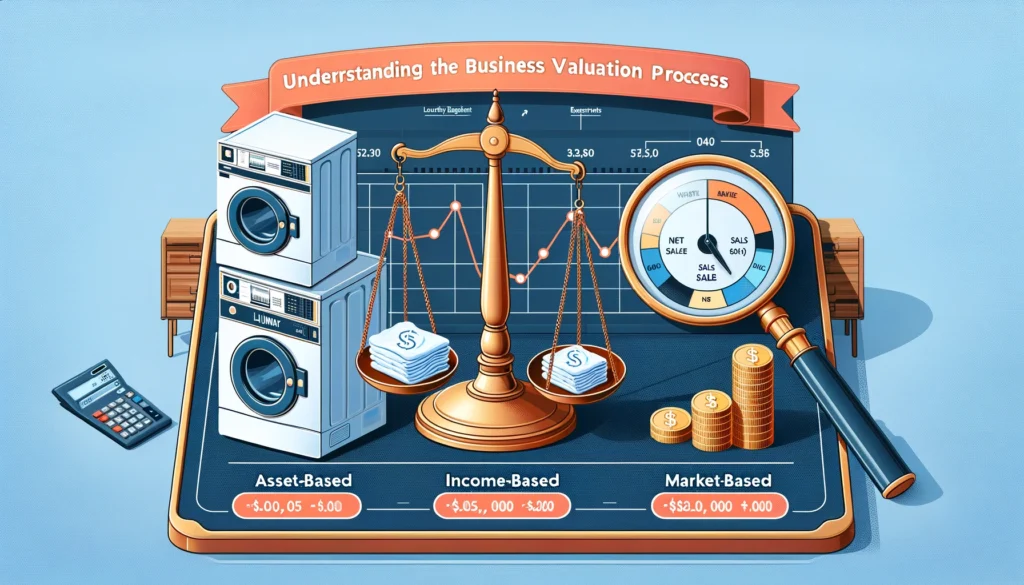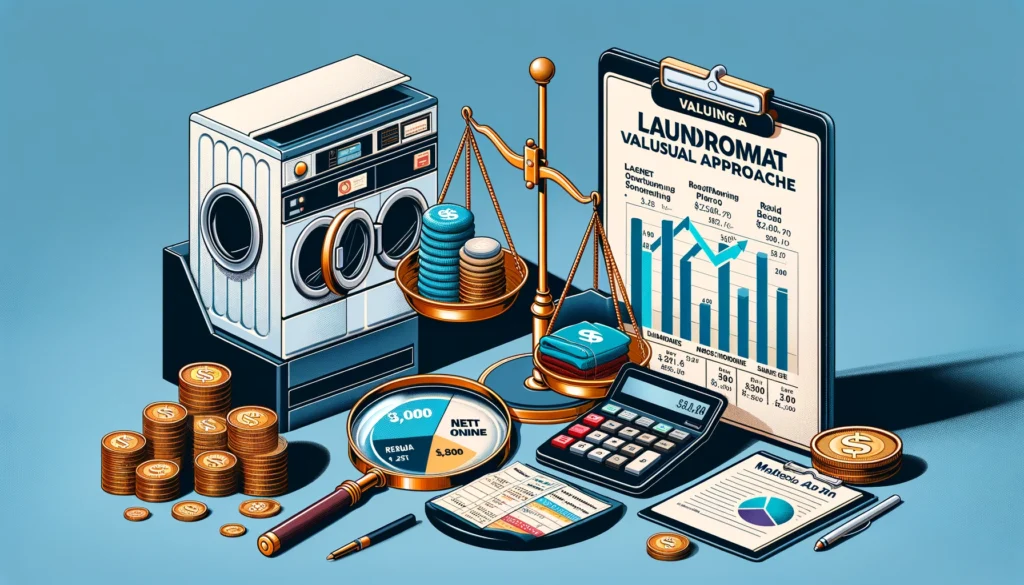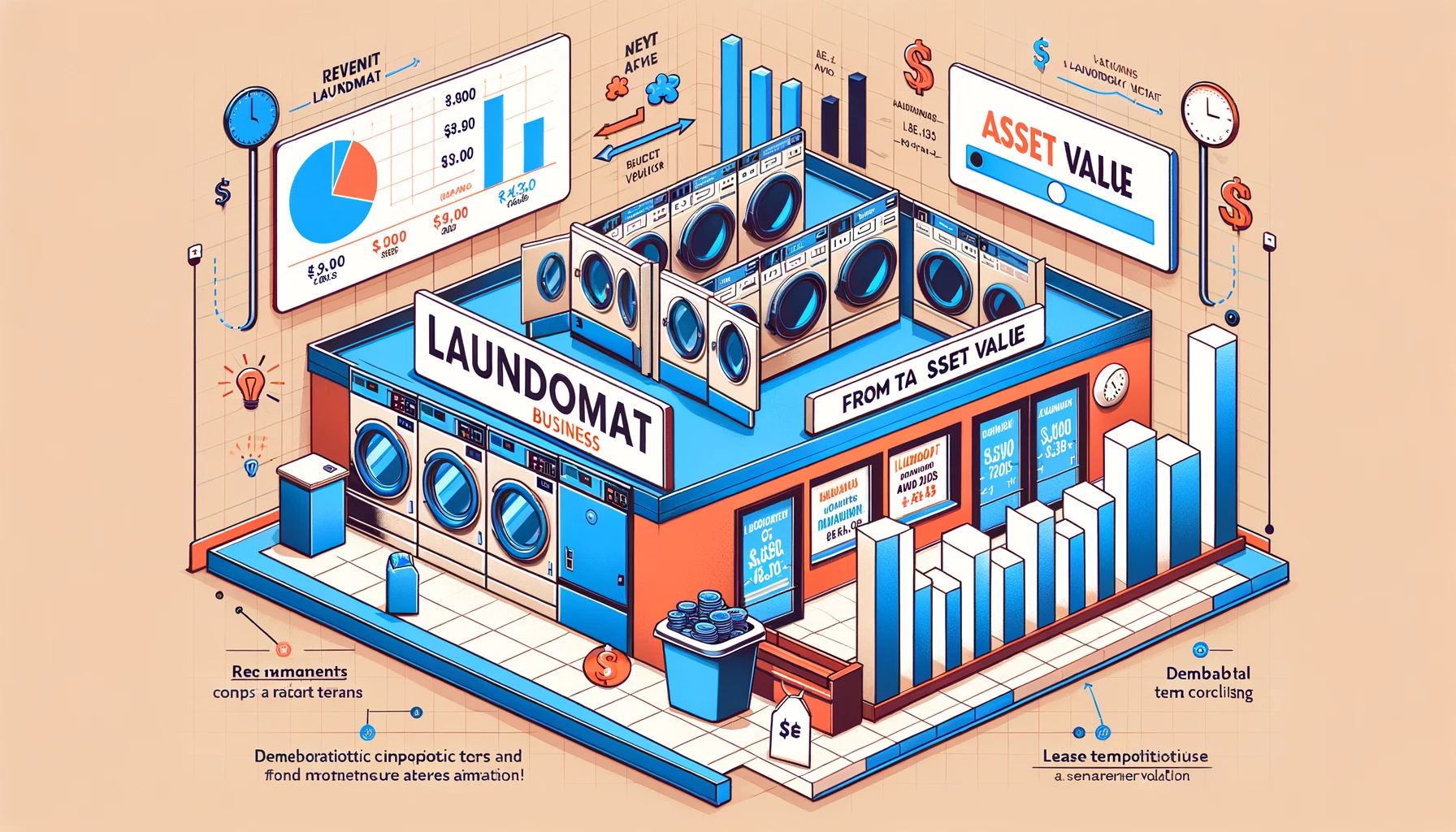Understanding how to value a laundromat business is crucial in today’s vibrant service industry. Laundromats have become increasingly vital service-based businesses within local communities. As laundromat owners consider selling their business or buyers look to invest in this industry, accurately determining the laundromat’s valuation and business worth is essential.
Properly assessing key valuation metrics like revenue, costs, assets, and market competition can impact sale price negotiations and financing decisions. So a comprehensive understanding of valuation methods is crucial. This article will provide laundromat sellers and buyers with a data-driven approach to evaluate all integral components that influence objective laundromat appraisals.
By outlining tactical formulas to calculate net operating income (NOI) based on both income streams and expenses, while also considering available assets. We aim to offer an accurate methodology any investor can follow to determine the true selling price and financial value of a store. With an overview of critical factors like demographics, lease terms, and equipment age. This guide details a customizable business valuation process to set realistic selling expectations.
By the end, readers will have the frameworks to holistically assess laundromat opportunities based on their unique revenue forecasts and cost structures. Now, let’s review the key drivers of value for this vital service business.
Understanding the Business Valuation Process
Determining the business value of a laundromat requires assessing it from financial, operational, and market perspectives. Business valuation provides a comprehensive framework for sellers to quantify their asking price and for buyers to justify an investment offer. The three core valuation approaches are:

- Asset-based: Assesses the fair market value of all owned assets, including washers, dryers, other equipment, vehicles, and real estate.
- Income-based: Estimates value based on the ongoing cash flows and profitability of the business. Analyzes revenue streams and expenses to project future net operating income (NOI).
- Market-based: Compares to sale prices for similar laundromat businesses in the same region. Considers comparator sales multiples.
For most laundromats, the income-based method provides the best representation of the current business health and earnings potential. By taking into account both income and costs, it balances current profitability with growth projections.
Key Drivers of Any Laundromat’s Value
While computing the income-based valuation in detail later using revenue and expense formulas, understanding which metrics influence value is vital:
- Lease Terms: Favorable long-term leases in desirable retail locations increase value by ensuring continued operations.
- Area Demographics: High neighborhood population, housing density, and pedestrian traffic feed customer utilization.
- Competition: Low market saturation with limited nearby laundry options boosts utilization and profit per customer.
- Equipment Age: Younger equipment has longer usable lifetimes before replacement is needed, preserving income.
Calculating a Laundromat’s Profitability Potential
A key metric in determining any business’ value is its net operating income (NOI). NOI represents profitability after all operating expenses are deducted from top-line revenue. Here is the basic formula:

NOI = Total Laundromat Revenue – Operating Expenses
- Total Revenue: For laundromats, the main revenue streams include washer and dryer usage fees, drop-off laundry services, and ancillary revenue like vending machines.
- Operating Expenses: On the expense side, major costs include equipment leases, staff wages, property taxes, insurance, utilities, and maintenance.
- NOI Calculation: Earnings before interest, taxes, depreciation, and amortization, or EBITDA, are represented by NOI. Take the operating costs and deduct these from the overall revenue.
Factors like yearly revenue and operational costs significantly influence NOI. A well-maintained laundromat with efficient equipment might have lower expenses, boosting NOI.
Factoring in Operational Costs and Expenses
While top-line revenue builds valuation foundations, properly estimating operating costs and margins is vital:
- Labor Costs: Staff wages, payroll tax, benefits per employee
- Utility Costs: Water, gas, and electric fees based on utility rates
- Maintenance Costs: Equipment/building upkeep and cleaning expenses
- Inventory: Laundry supplies and replacement machine parts
Evaluating these costs over time provides insight into the laundromat’s financial health. Historical costs help predict future expense ratios as a percentage of revenue. Existing margins indicate earnings potential.
Valuing a Laundromat Based on Revenue
Valuing a business based on revenue involves applying a revenue multiple. This multiple varies based on factors like location and market trends. For instance, a laundromat in a high-traffic area might command a higher multiple. In addition to NOI, a core valuation method uses a business’s annual revenue and a standard multiplier in the industry:
Laundromat Value = Annual Revenue x Valuation Multiple
- Track Income: Record income from all sources monthly.
- Annual Total: Multiply monthly averages by 12 for a yearly figure.
So if a laundromat generates $150,000 in yearly revenue, and the typical selling multiple is 2x, the valuation would be $300,000. The precise multiplier depends on factors like retail location, competition levels, and facility conditions. Recently sold comparable businesses in the area provide relevant valuation benchmarks.
Determining Valuation Multiples
Valuation multiples are ratios used to value a business. They compare one financial metric (like revenue or NOI) to the business’s market value. Factors influencing these multiples include:
- Industry Trends: Current trends in the laundry industry can affect multiples.
- Location: A prime location can command a higher multiple.
- Equipment Condition: Newer, well-maintained equipment can increase the multiple.
Multiples for successful laundromats often range from 3x to 5x of annual revenue or NOI depending on the overall business trajectory in terms of growth, costs, asset health, and buyer demand.
Additional Valuation Considerations
In addition to directly quantifying laundromat financials through NOI and valuation multiplier formulas, investors must assess qualitative factors that influence value:
- Customer Goodwill & Brand: A regular loyal customer base and strong regional brand carry intangible assets.
- Lease Terms: Favorable long-term leases in desirable locations increase overall asset value.
- Equipment Age: Newer equipment has a longer working life and requires less maintenance expense.
- Market Conditions: Growing area population and low competition increase potential customer base and utilization.
The Role of Assets in Laundromat Valuations
Laundromat equipment itself carries tangible balance sheet value influencing overall worth:

- Replacement Value: Cost to purchase equivalent utility of current assets
- Salvage Value: Trade-in or liquidation value for equipment
- Depreciation Schedules: Accounting formulas based on asset lifetime
Valuation also differs for leased versus owned equipment. Owned equipment adds to the assets of the business, potentially increasing its value.
Case Study: A laundromat with $150K revenue but only 10% leased equipment would have a lower valuation than another with $140K revenue and newer owned equipment.
Bringing Valuation Components Together into One Framework
Having covered the key drivers of laundromat business value from revenue to expenses to assets, let’s walk through an integrated 4-step valuation:
- Document All Revenue Streams & Expenses: Compile 3 years of historical data on usage fees, ancillary income, and detailed operating, payroll, maintenance, and inventory expenses.
- Project Future Earnings: Use past growth rates and market trends to forecast revenue and costs for the next 5 years. Calculate projected net operating income.
- Determine Valuation Multiple: Research recent comparable sales and industry benchmarks to identify appropriate multiples for both EBITDA and discretionary earnings valuations.
- Compute Value Across Multiple Models: Apply suitable multiples against future earnings projections. Also, generate an asset-based valuation of all owned equipment and real estate.
Compare valuation outputs to make an informed value conclusion, and identify variables with the largest influence. Use [this interactive calculator] to generate a custom laundromat valuation estimate.
While self-directed valuation provides a solid baseline understanding of opportunities, professional appraisal services can also evaluate key nuances within this customized framework. As laundromats remain in high investor demand, accurately assessing value helps both buyers and sellers.
Key Takeaways on Laundromat Valuations
Determining the fair market value for a laundromat business combines quantitative financial modeling with qualitative operational and market assessments into an overarching valuation framework:
- Forecast long-term revenue minus expenses to model earning capacity
- Select suitable valuation multiples based on profit metrics and business trajectory
- Account for intangible factors like customer base, brand equity, and lease terms
- Compute multi-parameter models to identify value range
For tailored valuations or appraisals, specialized laundromat brokers employ this methodology when representing buyers and sellers during acquisitions.

Conclusion
In summary, understanding how to value a laundromat business involves a blend of financial analysis, market research, and asset evaluation. While this guide offers a comprehensive overview, it’s important to seek professional assistance for an accurate and detailed appraisal.
For further learning and guidance, explore resources on business valuation, commercial real estate, and laundromat market analysis. Remember, a well-informed valuation is key to making sound investment decisions in the laundromat industry.
Muhammad Asif Saeed has extensive experience in commerce and finance. Specifically, He holds a Bachelor of Commerce degree specializing in Accounts and Finance and an MBA focusing on Marketing. These qualifications underpin his understanding of business dynamics and financial strategies.
With an impressive 20-year career in Pakistan’s textile sector, including roles at Masood Textile (MTM) and Sadaqat Limited, excelling in business & financial management. His expertise in financial and business management is further evidenced by his authoritative articles on complex finance and business operation topics for various renowned websites including businessproplanner.com,businesprotips.com,distinctionbetween.com, trueqube.com, and bruitly.com, demonstrating his comprehensive knowledge and professional expertise in the field.


1 thought on “How to Value a Laundromat Business: From NOI to Asset Value!”